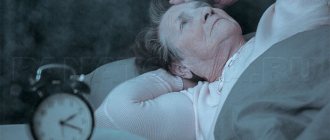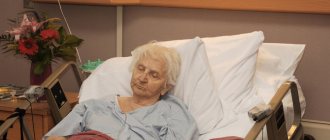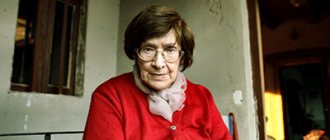Paranoia - what kind of disease is it, how does it affect the life of a person and the people around him. What is the urgency of the problem? What are the main causes and signs of paranoia, what is its differential diagnosis based on? Is it possible to effectively treat this disease? The answers to these questions are offered by the Chief Medical Doctor, practicing psychiatrist, psychiatrist-narcologist and psychotherapist Vladislav Sipovich.
What is paranoia and how relevant is its problem?
Paranoia, translated from Greek, literally means “next to the mind,” which can be regarded as a deviation from normal thinking towards exaggeration of one’s own personality and the ideas it produces while maintaining the logic of judgments. A person actually retains the ability to reason, but all his thoughts are aimed exclusively at proving his significance and recognition by society of his extremely valuable ideas. At the same time, self-criticism is practically absent, but the critical attitude towards people who do not share the idea of the exclusivity of the patient himself is literally off scale.
Paranoia is a rare type of chronic mental disorder that develops mainly in people who have reached adulthood. According to statistics, among patients undergoing treatment in psychiatric hospitals, the proportion of patients with paranoia is only 0.5-1%, and among all mental disorders it is 2-4%. Perhaps such low statistics are due to low detection, which in turn is associated both with the difficulty of differential diagnosis and with the patient’s non-recognition of his painful condition and maintaining the ability to integrate and function in society. A paranoid person is a person who is convinced of the value of his ideas and the prejudiced attitude of others. Attempts to prove the irrationality and unreality of the thoughts put forward by a paranoid only cause anger, distrust, hostility and even aggressiveness not only towards strangers, but also to close people themselves, as well as to specialists trying to help. Establishing contact with such a patient is extremely difficult and requires at the initial stage a partial recognition of the super-value and uniqueness of even the most crazy ideas. Paranoia is a disease that has such features as: • Gradual development without aggravating the pathological dynamics of symptoms and without increasing personality changes. In practice, this means the absence of apathy, decreased vitality, and abulia (loss of will and motivation). The patient’s nervous and energetic potential remains invariably high, aimed at achieving the goal, and internal dissatisfaction finds a way out in conflict with the outside world and the fight against imaginary injustice. • Logical validity and consistency of false ideas, which is almost impossible to refute. All objections have seemingly logical antitheses. • The theme of ideas is usually monodirectional, i.e. concerns a certain sphere of knowledge and activity of society. A classic example is graphomania, when a person, having once achieved the publication of his poems or stories, begins to consider himself an outstanding and unsurpassed poet or writer. The constant refusals of publishing houses to publish his “masterpieces” are perceived as the machinations of envious people, unprofessionalism and bias of editors, publishers, etc. It is almost impossible to prove the inconsistency of a paranoid’s claims, because he takes criticism as a personal insult and reacts with extreme hostility. Switching to another topic is uncharacteristic; the patient persistently achieves his goal and attacks various publishing houses ad infinitum. All these ordeals last for years and decades, causing extreme anger and hostility towards the whole world. • No hallucinations, e.g. distortions in the perception of reality. By the way, experts do not have a consensus on this matter; many sources acknowledge the existence of various types of illusions in paranoids, but usually these symptoms are observed in combined mental disorders, for example, paranoia-like delusions in schizophrenics. These phenomena have nothing to do with classical “pure” paranoia. • Consistent and generally predictable behavior based on the formal connection of many real elements with the false beliefs of the paranoid.
A patient with paranoia is characterized by extreme suspicion, blaming imaginary enemies for his failures, and a tendency to construct conspiracy theories against him in his imagination. The urgency of the problem is that one paranoid person can complicate the lives of many people, including not only those closest to him, but also those to whom he turns with his “projects”. The interests of a paranoid person include officials, specialized specialists, writers, directors, producers, public figures, judicial authorities, etc. Received refusals to satisfy requests and logical explanations do not stop the paranoid, but only strengthen his persistence. Sometimes he turns into a manic pursuer and may even descend to physical violence against those who refuse his protection.
Involutional (presenile) psychoses
Presenile psychoses (synonym: presenile psychoses, involutional psychoses) are a group of mental illnesses that arise at the age of 45-60 years and are manifested mainly by depression or delusions of harm and persecution. Presenile depression (involutional melancholia). The initial period lasts from several weeks to a year. It manifests itself as anxiety, motor agitation of varying intensity, hypochondria, as well as sleep disorders, loss of appetite, constipation, weight loss and aging. The full picture of psychosis is determined by confusion, increased anxiety and agitation, the appearance of speech excitation, persistent attempts at suicide or self-mutilation, the development of complex forms of depressive delirium, usually Cotard's delusion. Mental illnesses of late age are divided into involutional functional (reversible) psychoses that do not lead to the development of dementia , and senile organic psychoses that arise against the background of a destructive process in the brain and are accompanied by the development of severe intellectual impairment. Involutional psychoses include:
- involutional depression (melancholia);
- involutional paranoid.
The emergence and development of involutional psychoses is facilitated by a unique personality type with traits of rigidity, anxiety, suspiciousness, various traumatic situations, and previous somatic diseases.
Involutional psychoses in women develop, as a rule, after menopause (menopause), i.e. after a period of hormonal changes in the body. In other words, “menopause” is not the cause of involutional psychoses. Involutionary melancholy
Involutional melancholia is a prolonged anxious or anxious-delusional depression that first appeared at involutionary age. It is observed more often in women aged 50-65 years.
Symptoms and course:
The clinical picture of the disease consists of a depressed mood, with anxiety, fear, and confusion. Patients are in a state of motor restlessness, fussiness, which at times turns into anxious and melancholy excitement. They rush about, find no place for themselves, lament, repeat the same words. In this state, suicide attempts are possible.
The condition can become more complicated due to the addition of auditory illusions: in the conversation of others, condemnation, reproaches, and accusations are heard. Delusional ideas of self-accusation, condemnation, ruin, impoverishment or hypochondriacal content are added. Hypochondriacal ideas consist in the belief of patients in the presence of a serious somatic illness (cancer, heart disease, gastrointestinal tract), which is not confirmed by objective research.
In some cases, painful fears take extreme forms of denial of the functioning of individual organs and entire systems - “there is no stool and no urine is excreted.” The feeling of hopelessness and anxious anticipation can also manifest itself in a fantastically grandiose form - “everything is dying, a general catastrophe is happening: everything is due to my sinfulness: the only way out is fair retribution.”
Involutional melancholia has a long course. It lasts from several months to several years. Disease outcomes vary. Full recovery is possible, especially with timely and correct treatment.
Cases of a malignant course with increasing symptoms of general exhaustion are currently extremely rare. Sometimes, for many years, there is monotonous anxiety, fixation on one’s state of health, and a decrease in activity in terms of maintaining one’s appearance, everyday life, and communication with others.
Recognition:
The supporting signs for making a diagnosis of involutional melancholia are: the age of the patients, the absence of a history of mental disorders and attacks of depression, the predominance of a depressed mood in the patient’s state with anxiety, fear, fussiness, expectation of punishment for themselves and their loved ones, fixation of attention on the somatic state. However, if somatic complaints are persistent and it is impossible to exclude the presence of a particular disease, it is necessary to conduct a thorough physical examination using all modern diagnostic methods.
Treatment:
Antidepressants with a sedative effect are used in combination with small doses of antipsychotics (Sonapax, frenolone, etaprazine) to relieve fear, anxiety, and delusional disorders. Drugs are prescribed carefully, in the absence of contraindications, taking into account possible age-related reactions to drugs. If drug treatment is ineffective, electroconvulsive therapy is sometimes used. Treatment is usually carried out in a psychiatric hospital, because Constant monitoring of the patient’s physical and mental state is necessary, especially since the possibility of suicide attempts cannot be ruled out.
The prognosis is generally favorable. Either complete recovery occurs, or unstable sleep, headache, slight anxiety and some inner agitation persist for a certain time after recovery from psychosis. However, in any case, the ability to work remains, although many by this time are at retirement age. Usually they serve themselves and their loved ones, run the household, raise their grandchildren, communicate with neighbors and relatives, i.e. lead a full life.
Involutionary paranoid
Involutional paranoid is a psychosis that first appears at the age of involution (reverse development) and is characterized by delusions of a small scale or ordinary relationships.
Symptoms and course:
The disease is characterized by the gradual development of persistent delirium against the background of clear consciousness and outwardly relatively orderly behavior. The delusional concept involves people from the immediate environment (family members, neighbors, acquaintances), who are suspected of deliberately causing all sorts of troubles: sabotage, oppression, poisoning, damage; the delusional concept usually does not extend beyond narrow everyday relationships, which is why it is called delusion “ small scale" or "ordinary relationships".
Patients are convinced that their neighbors are spoiling their things, sneaking into the apartment, picking up keys and master keys, adding salt and toxic substances to their food, letting gas under the door, etc. Suspicious people visit their neighbors and are in conspiracy with them. Everything is done with the specific goal of “surviving” the patient from the apartment, causing material damage or harm to health.
At the same time, patients can interpret their bodily sensations in a delusional way. For example, coughing and palpitations are regarded as a result of gas poisoning, and stomach upsets and diarrhea are considered as poisoning from poisons added to food. Patients are distinguished by great activity and persistence in defending their delusional beliefs and fighting imaginary enemies.
They carry out surveillance, put numerous locks and seals on the doors, and write complaints to various authorities. Depressed mood, unlike melancholy, does not exist.
It is possible to develop delusions in terms of ideas of jealousy, more often in men. They are jealous of their neighbors in the apartment, at the dacha, and their colleagues. The most ordinary facts are interpreted in a delusional way. For example, a wife talked to a neighbor through the fence, which means she made an appointment, she accidentally met an acquaintance on the street - a pre-planned meeting. A delusional system is created with an inadequate assessment of past events (retrospective assessment).
Patients with delusions of jealousy are socially dangerous, because may try to deal with an imaginary lover or mistress, as well as with the object of jealousy (wife, husband). Outside the realm of delirium, patients maintain social connections, navigate everyday issues, and in some cases continue to work.
Recognition:
A distinctive feature of this disease is its late onset (after 50 years). The disease usually develops in a person prone to suspicion, punctuality, rigidity (stuckness), which later develop into conflict, hostility, and vindictiveness.
Even with a long course of the disease, there is no tendency to complicate delusional disorders, as is the case with schizophrenia, and dementia does not occur, unlike senile psychoses. Difficulties in determining the disease usually occur in its initial stages, when delusional statements of patients are mistaken for ordinary everyday quarrels and conflicts. It can be especially difficult to understand the situation in communal apartments, when real facts are intertwined with fictitious ones.
Treatment:
It is carried out in a hospital. Antipsychotics (triftazine, haloperidol) are used in combination with tranquilizers (seduxen, phenazepam). Treatment with hormonal drugs is ineffective and even contraindicated (the same applies to involutional melancholia). Changing your place of residence, sometimes recommended by doctors, brings only temporary relief. Patients calm down for a while, but then delusional statements resume (either the old theme comes to life, or they find new “enemies”).
The prognosis for timely treatment is favorable.
What is the differential diagnosis of paranoia based on?
If earlier in classical psychiatry paranoia was considered for a long time as an independent disease, then according to the modern international classification of diseases, 10th revision (ICD-10), it is not classified as a separate category, but is classified under the subcategory of delusional disorder. Paranoia should be differentiated from similar paranoid (paranoid) personality changes. The latter often accompanies many mental disorders, in particular schizophrenia, paraphrenia, social phobias, anxiety disorders, post-traumatic stress and borderline states, and alcoholic psychoses. The difference between paranoia and paranoid personality disorders (hereinafter BPD): • Paranoia is characterized by following one idea, for example, if a paranoid person is convinced that a neighbor is harming him, then he will not communicate with him, maintaining communication with another environment. A hostile and aggressive attitude towards certain people develops when they do not recognize the patient’s highly valuable ideas and when they make critical statements about him. With paranoid disorder, distrust of everyone and everything comes to the fore; colleagues, the CIA, the FSB and the whole world can be the objects of distorted ideas. At the same time, the presence of an initial extremely valuable idea is not at all necessary. • Paranoia is always distinguished by a consistently constructed and logically connected system of ideas, which is based on the acceptance of some idea as an axiom that does not require proof. Otherwise, thinking retains its rationality and allows paranoids to exist and function normally in society. They usually do not make friends, but they can have family relationships. In BPD, delusions are unsystematized and inconsistent. • In paranoia there are no hallucinations or illusions. Paranoid disorder is characterized by a distorted perception of reality. • Paranoid disorders are much more common than paranoia. For example, in the USA, about 2-4% of the population suffer from more or less severe mental disorders of the paranoid type. This is due to the fact that the very concept of BPD is broader and includes paranoia itself, endogenous (paranoid schizophrenia) and exogenous (provoked by stress, an unusual situation, etc.) paranoid psychoses. • With BPD, there is a progressive change in personality, which can lead to complete disorganization of thinking, which is not typical for classical paranoia with the preservation of structure, consistency and logic of thought processes. • The cause of paranoia is unknown. There are only hypotheses about genetic predisposition, but the gene itself responsible for its development has not been found. An external trigger that starts a psychopathological process can be any event, which is extremely difficult to identify. A number of factors predispose to the development of paranoid disorder. These include schizophrenia and delusional disorders in close relatives, problems of upbringing in a family with the use of violence, totalitarianism and increased parental care, as well as limited communication due to physical defects or illness. In fact, paranoid disorder is formed as a hypertrophied instinct of self-preservation, which leads to isolation, pathological suspicion and distrust of close and distant surroundings, constant readiness to defend against hostile, harmful persons and events. In addition, hallucinogens, amphetamines, alcohol and other chemicals can cause transient paranoia-like disorder. Only an experienced specialist can differentiate paranoia from paranoid disorder. Moreover, there is no complete clarity on this issue in psychiatry. The importance of the problem is that the choice of an effective method of treating it depends on the nature of the mental disorder.
Clinical picture
The content of delirium itself is not fantastic and is directly related to possible events. The patient may feel that they are scratching his furniture, or that cutlets are being stolen when he is not there. Ideas of poisoning are often encountered.
In this case, the patient believes that his relatives want to add poison to him. The mood is usually anxious and depressed, but it can also be elated. Often people believe the statements of patients, so elderly people with paranoia mislead others. Sometimes socially dangerous tendencies are observed, especially regarding sexual topics.
There is also a hallucinatory form of the disease, in which case the elderly person may hear threatening voices, they may violently condemn their actions. Most often, hallucinations are auditory.
But in some cases, other forms may be observed, for example, hypochondriacal tendencies, unpleasant sensations in different parts of the body. Very often, diseases concern the genital organs and are associated with the negative impact of offenders on them.
Involutional psychoses differ from depressive psychoses. Patients do not have negative suicidal symptoms, they do not show signs of depression, although there are complications with these signs. In matters of getting rid of imaginary ill-wishers, patients are especially active and fiercely defend their position. To achieve this goal, they involve the authorities and the public.
What types of paranoia are there?
The classification of individual types of paranoia is based mainly on the prevailing fixed idea. Depending on this, the most common forms of paranoia are distinguished: • Involutional paranoia, which develops at the mature age of 45-60 years, in women often coinciding with the menopause. It is characterized by systematized delusions of persecution, jealousy, and, less often, grandeur. The onset is usually acute, the course is long, and treatment is inpatient. • Paranoia of grandeur, or megalomaniacal with ideas of reforming society, science and art, as well as invention and “great” discoveries. • Paranoia of jealousy is based on the dogma of adultery or adultery. Moreover, betrayal does not need to be recorded and proven, but is accepted as an axiom. No arguments from the other half can shake the confidence of a pathological jealous person that he is right. Initially, the patient accuses the partner of coquetry, the desire to attract the attention of people of the opposite sex, cheeky behavior, shameless snuggling while dancing, and even a bashful reaction to compliments. This continues for several years, after which suspicions develop into a firm belief in treason. • A religious form that develops against the background of religious beliefs. • Erotic paranoia, in which the main content of delusional ideas is erotic fantasies. It develops mainly in women between 40 and 50 years of age. • Persecutory form – paranoia with systematized delusions of persecution. • Senile paranoia of old age, often coinciding with senile dementia, Alzheimer's disease, Parkinson's disease and other degenerative diseases of the brain. • Alcohol paranoia, which is a chronic psychosis caused by alcoholic encephalopathy. Most often it occurs in men and is manifested by delusions of jealousy and/or persecution. There are other types of paranoia, for example, with delusions of a complainer or hypnotic charm, but they are much less common.
What are the main signs of paranoia and its clinical picture?
The main symptoms of paranoia include such mental manifestations as: • The presence of overvalued ideas that become fixed ideas and haunt the patient throughout his life. At the same time, paranoids are as persistent as possible, spending all their energy and finances on proving the importance of their invention, discovery or method of reforming society. The literature describes a case when a man from Vladivostok “discovered” a new method of fishing, taking into account the location of the stars. He came to Moscow, knocked on the thresholds of various authorities, which gradually began to ignore him, went down and even spent the night at train stations. At the same time, the fate of his family abandoned in Vladivostok - parents, wife and children - did not bother him at all. • Overestimation of the role of one's own personality, leading to delusions of grandeur or persecution. In the first case, the patient considers himself capable of benefiting all of humanity, and in the second, that all the forces of the world are directed against him. For example, a neighbor's dog barks because the neighbors tease her to spite him, March cats yell specifically to disturb his sleep, children in the yard make noise in order to annoy him, etc. • Pathological suspicion, in which a person sees in everything the machinations of enemies and ill-wishers. He connects even the most insignificant events into a conspiracy theory he has built against himself. All this is accompanied by suspiciousness, rancor, vindictiveness, an inadequate assessment of criticism and a complete lack of a critical attitude towards one’s own actions. The patient does not accept other people's opinions; it is useless to prove the fallacy and inconsistency of his ideas. The paranoid person is convinced that everyone around him wants to harm him, take away his property, downplay his merits, exploit him and try to manipulate him in their own interests. As a result, a hostile attitude towards everyone around is formed, which, during an attack of acute paranoia, can turn into aggressive actions and make the patient dangerous even for the closest people. • Extreme susceptibility to stressful situations. The state of passion lasts a long time and with any memory of it “comes to life with renewed vigor. Even if a paranoid person does not show his emotions, then only with an eye to future revenge, because... he does not forgive insults. One’s own failures and mistakes are experienced very acutely due to wounded pride. Paranoids are extremely ambitious, characterized by arrogance and a tendency to overestimate their abilities and achievements.
Symptoms based on classification
The violation in question can occur in the following forms.
Symptoms of delusional form
Symptoms are characterized by moderate and not large-scale delusions of persecution from relatives and people living near the patient. An elderly person does not show signs of illness towards others.
He can tell how bad his relatives or colleagues are, but the interlocutor who is not one of them is not the culprit of all the troubles. During the delusional form, the main drama unfolds in the patient’s immediate place of residence - an apartment, a room.
Relatives or neighbors become guilty, a person is seized by a delusional idea of the desire to cause harm to him, it can take on different forms. For example, illegal entry into an apartment with the aim of waiting for death and seizing it
This form is characterized by attempts with varying degrees of success to get rid of pests and protect one’s property from theft. The patient may also try to save his life from invaders.
So, the main symptoms are:
- symptoms are most pronounced in an apartment or room;
- neighbors and relatives are the main culprits;
- the main complaint is home invasion;
- explanation for actions - desire to take possession of housing;
- the patient protects himself in every possible way from negative influences.
Symptoms of the hallucinatory form
During the day, auditory hallucinations appear as a symptom of this disease. A person can hear music, the sound of water and associate this with delusional ideas. The patient tries to stay in his apartment as little as possible.
Neighbors can also hear hallucinations; along with auditory ones, olfactory hallucinations can be observed. The patient can smell dichlorvos, chlorine, and other poisons. In this case, the delirium intensifies and becomes more stable.
The elderly person sees confirmation of his ideas, and when others point out their hallucinatory nature, the patient begins to quite rightly (as it seems to him) assume deception on their part. If the neighbors are pests, then the patient tries to carefully inspect their apartment to find confirmation that it is they who commit lawlessness and wish evil.
Main symptoms:
- auditory, olfactory or tactile hallucinations;
- delusions of persecution;
- events occur among neighbors;
- attempts to fence off harmful influences;
- attempts to inspect the neighbors' apartment.
What are the main ways to treat paranoia and how should others behave during an attack of paranoia?
Paranoia is a psychiatric illness that is very difficult to treat. This is explained by the fact that, due to his supernatural suspicion, the patient does not trust anyone or anything, spreading his suspicions to the doctor and the drugs he prescribes. He perceives psychotherapy as another attempt to manipulate his consciousness. In addition, the paranoid person categorically denies the painfulness of his condition, and loved ones who prove the need for treatment are transferred by the paranoid person to the category of “enemies.” The need for treatment becomes especially acute if a person ceases to be socialized, which is manifested by a readiness to isolate himself from the “persecuting” society or even to attack an object that he believes is harmful. This transition from the passive course of the disease to the active phase is an indication for inpatient treatment. In case of an attack of paranoia, it is necessary to call an ambulance, and unnoticed by the patient. Before the arrival of a specialized team, do not contradict the patient under any circumstances, accept his position and even play along slightly. Don't try to prove anything or appeal to common sense. This is useless and even dangerous, since the delusions of a paranoid cannot be corrected. If the arriving specialists cannot stop the attack and relieve psycho-emotional stress on the spot, the patient is hospitalized. In case of chronic paranoia, outpatient complex treatment is indicated, the main element of which is drug therapy with the use of anti-delusional antipsychotics. Their action is aimed at normalizing the exchange of neurotransmitters and blocking the excitation of nerve centers responsible for the symptoms of paranoia. The prescription of other pharmacological drugs is symptomatic in nature and is aimed at eliminating the symptoms of paranoia that prevail in a particular patient. For example, antidepressants are used to relieve depressive moods, tranquilizers to eliminate fear and anxiety, and sleeping pills to normalize sleep. An additional and important area of comprehensive treatment of paranoia is psychotherapy. It is aimed primarily at restoring socialization and eliminating elements of irrational behavior in patients with paranoia.
At the first stage of treatment, the main thing is to establish contact and trusting relationships with the patient. This is extremely difficult to achieve, but it is possible. If the patient himself has decided to undergo treatment and correctly assesses his condition, this is already half the success in getting rid of paranoia. Unfortunately, such a development of the situation is rarely observed. Most of these patients remain outside the attention of psychiatrists and psychotherapists (what is the difference between a psychiatrist and a psychotherapist) for a long time, sometimes for decades. If, during an exacerbation, situations arise that are life-threatening to the patient himself (auto-aggression) and/or his environment, then only then does treatment begin, usually in an inpatient setting. The choice of drugs, as well as psychotherapeutic methods of correction, depends on many factors - on the general physical condition of the body, mental characteristics, gender, age and basic symptoms.
When taking medication, it should be borne in mind that abruptly stopping medication can lead to the so-called withdrawal syndrome, when, after stopping treatment, the symptoms of the disease return again and sometimes with greater force than before treatment.
Only drug therapy, not supported by psychotherapy, is not capable of completely returning the patient to normal life in society. It is possible to achieve stable and long-term remission only with the use of both methods of therapy - medication and psychotherapy. The most effective treatments for paranoia include Gestalt therapy, cognitive behavioral therapy (CBT) and psychodynamic psychotherapy. Unfortunately, paranoia is a disease that takes a long time and is difficult to treat, sometimes for 10 years. If treatment is carried out on an outpatient basis, then it is important to take medications according to the regimen developed by the doctor, regular psychotherapy sessions, follow the recommendations of the psychotherapist, use the acquired communication skills, and after achieving remission, periodic consultations with the specialist supervising the patient.
On special delusional psychoses of late age (paranoid housing)
Professor, Doctor of Medical Sciences, Head of Department, V.A. Kontsevoy, Doctor of Medical Sciences, A.V. Medvedev
Department of Gerontopsychiatry, National Center for Mental Health, Russian Academy of Medical Sciences
Complaints and complaints about various kinds of inconveniences and difficulties of living with neighbors or relatives are very common. Most often, they are completely justified and reflect real situations associated with persistent conflicts in the family, apartment or house. At the same time, among the people making such complaints, there are also those whose negative experiences associated with living in the same apartment or house with relatives or neighbors have a deeply painful, delusional basis. As a rule, these are elderly and senile people. Due to the ordinariness, banality, and plausibility of such complaints (“neighbors or relatives do not allow you to live in peace,” “commit petty thefts,” “insult you,” “trying to survive from the apartment,” etc.) they do not always and usually not immediately are regarded as manifestations of mental illness. But even in cases where the patient’s statements should raise alarm bells regarding the possible development of a mental illness (“neighbors are trying to poison”, “they are putting something under the door”), they are often viewed as an exaggeration of the real situation by an old person, as harmless “senile suspiciousness.” " Meanwhile, such people not only suffer themselves, but can also become dangerous to others.
The psychoses in question are known in the literature as “involutional paranoids.” We prefer to label them as “housing paranoids.” This designation, in our opinion, more fully reveals the clinical, psychopathological and social problems associated with these psychoses.
Epidemiology. There is no exact information about the prevalence of these psychoses among the population. According to our data, among people over 60 years of age who suffer from late-onset delusional psychoses (with onset after 45 years of age) and are registered at a psychoneurological dispensary, such patients account for more than 2/3.
Clinical picture. The most significant general feature of “housing paranoid” is that the delusional and hallucinatory symptoms that make up its clinical picture appear to be “tied” exclusively or almost completely to the patient’s place of residence. In other words, all “delusional events” occur either in the patient’s apartment or in nearby (usually adjacent) apartments. Outside the living situation (on the street, at work, in the clinic, etc.), delusional formation does not occur, and if individual delusional elements arise, they turn out to be only a small part of the “delusional drama” that plays out in the patient’s place of residence. This drama is experienced by the patient as a painful constraint (even unbearable) of his existence where, it would seem, he should feel most protected and comfortable.
The themes of delusional experiences are as diverse as the actual conflicts that arise between people living together or in the neighborhood can be. However, the most typical of them are survival from the apartment, theft, poisoning, hooligan behavior or simply too noisy behavior of neighbors. True, obviously absurd, fantastic ideas are also possible (neighbors manipulate the patient’s body at night, “homeless people have settled in special spaces” in his apartment, etc.).
Clinical options. Depending on the leading structural elements of delusion, there are two main variants: delusional and hallucinatory.
The delusional (paranoid) variant itself generally corresponds to the so-called “presenile delusion of damage,” first identified and sketchily described at the beginning of our century by the outstanding German psychiatrist E. Kraepelin and studied in detail by domestic psychiatrists. Most often, delirium is of a purely “in-house” nature. The main events that make up its content are played out in these cases in the place of the patient’s immediate residence (in his apartment, room), and the main characters involved in the delirium are the roommates or relatives living with the patient. For such patients, one of the main complaints is about strangers entering their room or apartment. As evidence of such statements, as a rule, observations are given about the disappearances, substitutions, damage or movements of things that occur among them, and the discovery of “poison or dirt” in food.
At the same time, patients claim that their neighbors infringe on their interests in every possible way and do not allow them to use the kitchen, bathroom, or toilet. For such patients, delusional ideas of theft, material and moral damage, and sometimes poisoning are typical. The main “explanation” for this behavior of neighbors most often comes down to their desire to take over the patient’s living space. The delusional behavior of patients is also very typical. On the one hand, they take additional measures aimed at preventing strangers from entering their homes (numerous constipations and locks) and obtaining “material evidence” of such penetration (gluing strips of paper or thread on door cracks, sprinkling the floor with powder to detect traces). On the other hand, patients tend not to leave their homes unless absolutely necessary. They place all their belongings in the room, including kitchen utensils and groceries, and prefer to do all their household chores here.
The hallucinatory variant of housing paranoia, most fully described in Russian literature, is determined by the dominance of perceptual deceptions in the clinical picture of psychosis. In this case, they are usually limited to so-called “elementary” hallucinations, most often auditory. In these cases, a kind of “acoasmatic” hallucinosis syndrome occurs. Patients complain that they are constantly, and especially in the evening and at night, disturbed by the noise of water pouring from taps, the hum of water pipes, the sound of hammers, stomping, music, clinking of dishes, etc. Less common are olfactory hallucinosis, when patients, for example, claim that their apartment always smells of bleach, insecticides, smoke, etc. In isolated observations, tactile-thermal sensations may predominate with the sensation of flows of hot and cold air. Verbal hallucinations as leading manifestations of housing paranoia are not common. Regardless of whether hallucinations belong to one analyzer or another, a simultaneous change in the general well-being of patients with the experience of painful bodily discomfort, with unpleasant sensations in the head, heart, and stomach is typical.
In contrast to the actual delusional variant of housing paranoia, in its hallucinatory variant, delusional events go beyond the patient’s immediate residence and spread to neighboring apartments, and the sphere of delusion primarily involves persons living in these apartments, sometimes unfamiliar to the patients. In other words, in such cases, psychoses are, as it were, “inter-apartment” in nature. Patients claim that the source of those painful sensations (auditory, olfactory, tactile) that they experience at home are various kinds of actions of the residents of the neighboring apartment.
Moreover, at the moments of the most intense hallucination, patients may have vivid, figurative (even scene-like) ideas about the activities that their neighbors are engaged in at that time. Thus, patients report that they “almost see” how their neighbors move around their apartment, perform various kinds of manipulations with certain objects (pouring water into vessels, knocking on the floor with a hammer, releasing “odorous substances,” etc.) .
Another distinctive feature of the hallucinatory variant of housing paranoia is the variety of individually possible content of delusions. Along with delusions of damage and poisoning, delusions of physical influence are also observed, when patients say that their neighbors act on them with special sound waves or electric current using special devices. However, cases in which persecutory delusions are completely absent are particularly highlighted. Such patients exclude the idea that their neighbors are intentionally harming them. They consider themselves random victims of some ongoing activity of their neighbors, most often cottage industry, accompanied by noise or associated with the use of substances with a strong and unpleasant odor. True, often this kind of imaginary activity of neighbors is assessed by patients as “underground”, as “criminal business”.
The behavior of patients with the hallucinatory variant of housing paranoia is characterized by, firstly, the desire to spend as little time as possible in their apartment, secondly, the implementation of various kinds of protective measures that prevent extraneous sounds and smells from entering their apartment, and thirdly, persistent attempts “inspect” the neighbors’ premises in order to obtain “evidence” of their activities, which cause them constant disturbance.
Both the delusional and hallucinatory variants of housing paranoia are often accompanied by affective disorders with both negative and positive connotations. Manifestations of low mood can vary from dysphoria, anger, and fear closely associated with delusions to varying degrees of depression and anxiety. The behavior of these patients is more often of a passive-defensive nature. At the same time, they may have suicidal attempts, which they make in a state of hopeless despair or fear. Affective disorders with a positive connotation can be represented by sthenic-elevated mood (sometimes with elements of anger), obvious hypomania, and finally, persistent complacency. Such patients are often characterized by litigious behavior with repeated appeals to various authorities. Some of them are prone to dangerous actions with aggression towards neighbors and relatives involved in their delusional constructions.
Risk factors. Factors predisposing to the development of paranoid housing, in addition to elderly and senile age, should be considered anomalies in the personality make-up of patients, as well as features of the family genetic background. Before the onset of the disease, many patients exhibit paranoid traits with distrust and a tendency to undeveloped paranoid ideas (jealousy, hostility), which arise more often in ordinary conflict situations. Many patients also exhibit traits of psychosexual immaturity. Often attention is drawn to a low level of intelligence with simplified and straightforward judgments regarding various life situations, relationships between people, as well as narrow interests. Among the close relatives of patients, there are often people with a similar personality type. In addition, there is a slightly pronounced family burden of cases of paranoid schizophrenia and other delusional psychoses, including late ones. It should also be noted a number of so-called “critical life events”, which often provoke the development of paranoid housing. These include: a change in living conditions, primarily the emergence of a new interpersonal situation that requires adaptation (change in family composition, for example, due to the death of a spouse or moving out with relatives), a change of neighbors, moving to a new apartment. The role of loneliness postulated by some authors in the genesis of the described psychoses cannot be considered strictly proven.
Nosological varieties. Housing paranoid is a syndrome that can occur with various mental illnesses developing in elderly and senile people, namely late paranoid, late paranoid schizophrenia, reactive paranoid, induced paranoid and late dementia.
Late paranoid is the most typical and independent form of chronic delusional psychosis, within which housing paranoid syndrome manifests itself. It occurs without the so-called “rank I symptoms” and the phenomena of increasing mental defect characteristic of paranoid schizophrenia. In these cases, 4 - 6 years after the onset of psychosis, there is usually a stabilization of the clinical manifestations of the disease, and after 10 - 15 years - their reduction, usually with the preservation of residual delusional symptoms. A number of patients, especially after they reach 70 years of age, exhibit mild and non-progressive phenomena of mnestic weakness.
Late paranoid schizophrenia with housing paranoid syndrome is less common. In these cases, so-called schizophrenic “rank I symptoms” occur. Usually they are limited to delusional ideas of physical influence; less often, verbal hallucinations with commentary voices are possible. Also, in patients with schizophrenia, delusions can acquire an obviously absurd, fantastic character. At the same time, as with late schizophrenia in general, patients usually do not have a mental defect (at least pronounced) with emotional flattening or thinking disorders. The course of the disease is often paroxysmal.
Reactive paranoid. In these cases, housing paranoid syndrome is essentially a reactive delusional state. It arises in conditions of a real and far-reaching conflict with neighbors or relatives, which carries a serious danger of deterioration of the patient’s living conditions up to the point of his relocation to a boarding house (as a result, for example, of the actions of relatives or neighbors to exchange living space). At the same time, the patient begins to express unreasonable fears of being poisoned or killed. Once the situation is resolved, these fears disappear, but a critical attitude towards them does not always appear.
Induced paranoid is a more common variant of housing paranoid, formed through the mechanisms of reactive delusional formation. In a reduced form, it is often found in close relatives (spouses or sisters) of patients. Typically, this kind of induced delusional formation reproduces the most plausible elements of the inducer's psychosis. At the same time, the pathological activity (and primarily of a litigious nature) of people with induced paranoid housing can be very high, and sometimes even exceed the delusional activity of the inducers.
Late dementia with housing paranoid syndrome is most often represented by Alzheimer's disease or vascular dementia. In such observations, delusional and hallucinatory disorders develop against the background of mnestic-intellectual disorders and often turn out to be fragmentary. In this case, a tendency towards confabulation may be noticeable.
Diagnosis of housing paranoia is a very important procedure, since it affects not only the aspect of the medical assessment of the patient’s condition, but also his social status, primarily related to the possibility of his independent living and ownership of living space. Therefore, before finally making this or that diagnostic judgment, the doctor must not only have the most complete information possible (both from the words of the patient and from the words of those living with him) related to psychosis itself, but also form an objective idea of that microsocial situation , which has developed around the patient at his place of residence. There are cases when neighbors or relatives, truly interested in the patient’s living space or wanting to get rid of a characterologically “inconvenient” old person, give deliberately distorted information about the patient, “strengthening” the manifestations of mental pathology, and sometimes simply falsifying it. In other words, as a result of analyzing the information he has, the doctor must be confident that he is really dealing with a case of delusional psychosis, and not with an acute housing conflict, although perhaps overly interpreted by the patient.
According to the modern international classification of mental illnesses ICD-10 [10], the following options for the diagnostic qualification of late delusional psychoses occurring with housing paranoid syndrome are possible. In the most typical cases, in which its clinical manifestations are limited to delusional disorders of ordinary content, including the presence of elementary auditory or olfactory hallucinations, a diagnosis of “delusional disorder” is made as a variant of “chronic delusional disorder” (F22.0). Cases with verbal hallucinosis of a non-commentary nature should be classified under the heading “other chronic delusional disorders” (F22.8). Patients with delusions of physical influence or delusions with fantastic content or with the presence of commentary voices are diagnosed with paranoid schizophrenia (F20.0). Delusional disorders that arise as a reaction to a serious intra-apartment (or inter-apartment) conflict correspond to the rubric “Other acute predominantly delusional psychotic disorders” (F23.3). Persons with an induced variant of housing paranoia are diagnosed with induced delusional disorder (F24). If psychosis develops as part of dementia, then the main diagnosis will be the corresponding form of dementia, for example, “dementia in Alzheimer's disease” (FOO) or “Vascular dementia” (F01). In this case, an additional (fifth) sign indicates the presence of a delusional (.x1) or hallucinatory (.x2) disorder in the patient.
Organization of medical care. If the patient’s presence of full-blown delusional psychosis is beyond doubt, he is registered as a psychiatric patient at a psychoneurological dispensary and offered treatment.
The best option is to hospitalize the patient in a specialized (gerontological) department of a psychiatric hospital. The very removal of the patient from his usual habitat, to which his delusional and hallucinatory disorders are “attached,” as a rule, turns out to be the most important therapeutic measure, putting an end to these disorders or, at least, significantly weakening them. At the same time, the patients themselves note a feeling of psychological relief: they calm down, their sleep improves. In addition, in a hospital setting, patients undergo a comprehensive somatoneurological examination, which (especially considering their age) is very important for choosing adequate pharmacotherapy. In addition, it is extremely important that the treatment of a delusional patient, especially in the first stages, is carried out under the supervision of medical personnel, since such patients are very wary, and sometimes even clearly negative, about psychopharmacotherapy.
However, hospitalization of a patient often turns out to be difficult, sometimes not only because of the categorical refusal of the patients themselves, but also of their relatives, especially in cases where they act as inducers. Therefore, it is very important for a doctor to establish contacts not only with the patient, but also with his relatives, who sometimes themselves need psychotherapeutic correction of their induced delusional ideas. In such cases, it is often effective to instruct the patient on the advisability of undergoing general somatic and restorative treatment in a hospital setting in order to “calm the nerves” shaken as a result of the long-term conflict situation that has developed in the apartment. In cases where it is not possible to obtain the consent of the patient or his relatives for hospitalization, the solution to this issue depends on an assessment of the degree of social danger of the patient both for himself and for those living with him. If such a danger exists, the patient is forcibly admitted to a psychiatric hospital in accordance with currently existing legislation. If the patient’s behavior does not seem socially dangerous, then, if possible, outpatient treatment should be organized, which is advisable to begin in a day hospital.
Psychopharmacotherapy, which is necessarily carried out by patients with housing paranoid syndrome, must be strictly differentiated. The nosological affiliation of psychosis, its syndromic structure, the age of the patients, and their somatoneurological state should be taken into account.
In patients of involutionary age (up to 60 - 65 years) in the absence of severe somatoneurological pathology, a wide range of psychopharmacological agents can be used, primarily antipsychotic drugs with antipsychotic action, such as haloperidol, stelazine, etaprazine. It is also possible to use leponex, and among the new generation drugs - resperidone or alanzepine. In the presence of depressive disorders, treatment with antidepressants is indicated, primarily those that have sedative, anti-anxiety properties (amitriptyline, ludiamil, anafranil, gerfonal). Modern antidepressants with minor side effects include sertraline and coaxil. If there is a pronounced delusional affect combined with tension and anger, you should immediately start using medium doses of antipsychotics. In the first days of therapy, it is possible to combine haloperidol with a single use of chlorpromazine, which is administered parenterally (intramuscularly). In other cases, the doses of drugs should be increased gradually (over 1 week), but the dosages should not exceed average values. For patients with severe anxiety and tension, it is advisable to prescribe tranquilizers (Relanium, alprazolam) in the first week. Approximately a month after the start of therapy, provided that the antipsychotics are satisfactory tolerable, it is advisable to transfer the patient to long-acting drugs. Preferably haloperidol decanate is prescribed in small doses, combining it, if necessary, with the additional administration of conventional drugs.
Treatment of patients over 65-70 years of age or with severe somatoneurological pathology should be more careful. Such patients should be treated with small doses of haloperidol with the addition of milder neuroleptics in medium doses (sonapax, chlorprothixene). But even in such patients, in the absence of pronounced adverse reactions, it is possible to use haloperidol decanate in minimal doses.
In general, therapy for chronic psychoses with housing paranoid syndrome should be quite long and continue after the patient is discharged from a psychiatric hospital for at least 2 - 2.5 years.
In patients with abortive variants of housing paranoid, especially those developing through reactive mechanisms, one should limit oneself to short courses of therapy with small doses of antipsychotics (haloperidol) and tranquilizers, focusing on psychotherapeutic measures.
In cases where delusional psychosis develops against the background of dementia, short courses of drugs in low dosages are also advisable. In this case, you should avoid drugs with a pronounced anticholinergic effect (aminazine, amitriptyline), which can easily cause confusion (delirium) in such patients.
Published with permission from the administration of the Russian Medical Journal.











